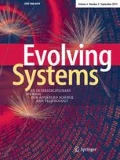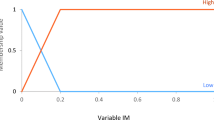Abstract
Past decades have witnessed the advancement of wireless sensor networks (WSNs) in both academic and industrial communities. Clustering is one of the most popular methods to increase the lifespan of WSNs. The optimal number of cluster heads and how to organize the clusters are the most important issues to be addressed in the clustering methods. In this paper, we proposed a novel user-independent and dynamical method to calculate the optimal number of clusters, organize the clusters, and determine the best cluster heads in each round. In this method, efficient energy consumption and link quality were considered to compute the optimal number of clusters. Then, the algorithm began to organize the compact clusters with high energy level cluster heads. We investigated a new fitness function in order to achieve these objectives. A new version of gravitational search algorithm (GSA) was used to solve this optimization problem. In this algorithm, the power distance sums scaling method was applied to calculate the mass values. Then, a fuzzy logic controller is employed to identify the parameter of this algorithm to control the exploitation and exploration abilities of the method during the computational process of the algorithm. Then, the novel version of GSA was applied to reach an appropriate solution for the fitness function, find the optimal number of clusters, and properly organize these clusters. To evaluate the effectiveness of the proposed method, several experiments were performed and the obtained results were compared with the results of other popular clustering methods. The simulation results revealed that the performance of the modified GSA was better than other state-of-the-art meta-heuristic optimization algorithms. Moreover, the proposed method for the clustering problem in WSNs outperformed other popular clustering methods and increased the lifetime of WSNs.







Similar content being viewed by others
References
Abbasi AZ, Islam N, Shaikh ZA (2014) A review of wireless sensors and networks’ applications in agriculture. Comput Standards Interfaces 36(2):263–270
Abdul Latiff NM, Tsimenidis CC, Sharif BS (2007) Energy-aware clustering for wireless sensor networks using particle swarm optimization. In: 2007 IEEE 18th international symposium on personal, indoor and mobile radio communications. IEEE, Athens, pp 1–5
Agarwal PK, Procopiuc CM (2002) Exact and approximation algorithms for clustering. Algorithmica 33(2):201–226
Akyildiz IF et al (2002) Wireless sensor networks: a survey. Comput Netw 38(4):393–422
Altinoz OT, Yilmaz AE, Weber G-W (2014) Improvement of the gravitational search algorithm by means of low-discrepancy sobol quasi random-number sequence based initialization. Adv Electr Comput Eng 14(3):55–62
Angelov P, Yager R (2013) Density-based averaging—a new operator for data fusion. Inf Sci 222:163–174
Angelov P, Ramezani R, Zhou X (2008) Autonomous novelty detection and object tracking in video streams using evolving clustering and Takagi-Sugeno type neuro-fuzzy system. In: 2008 IEEE International Joint Conference on Neural Networks (IEEE World Congress on Computational Intelligence). IEEE, Hong Kong, pp 1456–1463
Bapat V et al (2017) WSN application for crop protection to divert animal intrusions in the agricultural land. Comput Electr Agric 133:88–96
Baruah RD, Angelov P (2012) Evolving local means method for clustering of streaming data. In: 2012 IEEE international conference on fuzzy systems. IEEE, Brisbane, QLD, pp 1–8
Baruah RD, Angelov P (2014) DEC: dynamically evolving clustering and its application to structure identification of evolving fuzzy models. IEEE Trans Cybern 44(9):1619–1631
Bin S, Xinyun J (2014) Applications of compressive sensing in target tracking of wireless sensor networks. J Electr Measure Instrum 5:001
Chao Y et al (2016) A novel gravitational search algorithm for multilevel image segmentation and its application on semiconductor packages vision inspection. Optik-Int J Light Electron Opt 127(14):5770–5782
Cho MY, Hoang TT (2017) A differential particle swarm optimization-based support vector machine classifier for fault diagnosis in power distribution systems. Adv Electr Comput Eng 17(3):51–61
Coca E, Popa V (2012) A practical solution for time synchronization in wireless sensor networks. Adv Electr Comput Eng 12(4):57–62
Dahiya P, Sharma V, Naresh R (2015) Solution approach to automatic generation control problem using hybridized gravitational search algorithm optimized PID and FOPID controllers. Adv Electr Comput Eng 15(2):23–34
Das P, Behera HS, Panigrahi BK (2016) A hybridization of an improved particle swarm optimization and gravitational search algorithm for multi-robot path planning. Swarm Evol Comput 28:14–28
Edwards-Murphy F et al (2016) b + WSN: smart beehive with preliminary decision tree analysis for agriculture and honey bee health monitoring. Comput Electron Agric 124:211–219
Elhabyan RS, Yagoub MC (2014) Energy efficient clustering protocol for WSN using PSO. In: 2014 Global information infrastructure and networking symposium (GIIS). IEEE, Montreal, QC, pp 1–3
Fan C-S (2016) HIGH&58; a hexagon-based intelligent grouping approach in wireless sensor networks. Adv Electr Comput Eng 16(1):41–46
Fang W et al (2012) Cluster-based data gathering in long-strip wireless sensor networks. Adv Electr Comput Eng 12(1):3–8
Friedman M (1937) The use of ranks to avoid the assumption of normality implicit in the analysis of variance. J Am Stat Assoc 32(200):675–701
Furtak J, Zieliński Z, Chudzikiewicz J (2016) Security techniques for the WSN link layer within military IoT. In: 2016 IEEE 3rd World Forum on Internet of Things (WF-IoT). IEEE, Reston, VA, pp 233–238
González B et al (2015) Fuzzy logic in the gravitational search algorithm for the optimization of modular neural networks in pattern recognition. Expert Syst Appl 42(14):5839–5847
Heinzelman WR, Chandrakasan A, Balakrishnan H (2000) Energy-efficient communication protocol for wireless microsensor networks. In: Proceedings of the 33rd annual Hawaii international conference on system sciences. IEEE, Maui, HI, p 10. https://doi.org/10.1109/HICSS.2000.926982
Iglesias JA et al (2010) Evolving classification of agents’ behaviors: a general approach. Evol Syst 1(3):161–171
Islam MR, Kim J (2009) Cooperative technique based on sensor selection in wireless sensor network. Adv Electr Comput Eng 9(1):56–62
Jannu S, Dara S, Kumar KK, Bandari S (2018) Efficient algorithms for hotspot problem in wireless sensor networks: gravitational search algorithm. In: Thampi S, Mitra S, Mukhopadhyay J, Li KC, James A, Berretti S (eds) Intelligent systems technologies and applications. ISTA 2017. Advances in intelligent systems and computing, vol 683. Springer, Cham, pp 41–53
Li M, Lin H-J (2015) Design and implementation of smart home control systems based on wireless sensor networks and power line communications. IEEE Trans Industr Electron 62(7):4430–4442
Li X, Engelbrecht A, Epitropakis MG (2013) Benchmark functions for CEC’2013 special session and competition on niching methods for multimodal function optimization. RMIT University, Evolutionary Computation and Machine Learning Group, Australia, Tech. Rep
Markovic GZ (2016) Wavelength converters placement in optical networks using bee colony optimization. Adv Electr Comput Eng 16(1):3–10
Masehian E, Sedighizadeh D (2010) Multi-objective PSO-and NPSO-based algorithms for robot path planning. Adv Electr Comput Eng 10(4):69–76
Mekonnen MT, Rao KN (2017) Cluster optimization based on metaheuristic algorithms in wireless sensor networks. Wireless Pers Commun 97(2):2633–2647
Mood S, Rasshedi E, Javidi M (2016) New functions for mass caculation in gravitational search algorithm. J Comput Secur 2(3)
Muruganathan SD et al (2005) A centralized energy-efficient routing protocol for wireless sensor networks. IEEE Commun Mag 43(3):S8–13
Nezamabadi-pour H (2015) A quantum-inspired gravitational search algorithm for binary encoded optimization problems. Eng Appl Artif Intell 40:62–75
Oh B et al (2010) Genetic algorithm-based dynamic vehicle route search using car-to-car communication. Adv Electr Comput Eng 10(4):81–86
Raghuvanshi AS, Tiwari S, Tripathi R, Kishor N (2010) Optimal number of clusters in wireless sensor networks: an FCM approach. In: 2010 International Conference on Computer and Communication Technology (ICCCT). IEEE, Allahabad, Uttar Pradesh, pp 817–823
Rashedi E, Nezamabadi-Pour H, Saryazdi S (2009) GSA: a gravitational search algorithm. Inf Sci 179(13):2232–2248
Rodríguez-Fdez I, Canosa A, Mucientes M, Bugarín A (2015) STAC: a web platform for the comparison of algorithms using statistical tests. In: 2015 IEEE international conference on fuzzy systems (FUZZ-IEEE). IEEE, Istanbul, pp 1–8
Rotariu C, Manta V, Ciobotariu R (2013) Integrated system based on wireless sensors network for cardiac arrhythmia monitoring. Adv Electr Comput Eng 13(1):95–100
Sarafrazi S, Nezamabadi-Pour H, Saryazdi S (2011) Disruption: a new operator in gravitational search algorithm. Scientia Iranica 18(3):539–548
Shams M, Rashedi E, Hakimi A (2015) Clustered-gravitational search algorithm and its application in parameter optimization of a low noise amplifier. Appl Math Comput 258:436–453
Shanthi G, Sundarambal M (2018) FSO–PSO based multihop clustering in WSN for efficient medical building management system. Cluster Comput. https://doi.org/10.1007/s10586-017-1569-x
Shi Y, Eberhart R (1998) A modified particle swarm optimizer. In: 1998 IEEE international conference on evolutionary computation proceedings. IEEE world congress on computational intelligence (Cat. No.98TH8360). IEEE, Anchorage, AK, pp 69–73
Tang Z, Tian Y (2011) Wireless meter reading based energy-balanced steady clustering routing algorithm for sensor networks. Adv Electr Comp Eng 11(2):9–14
Vijayalakshmi K, Anandan P (2018) A multi objective Tabu particle swarm optimization for effective cluster head selection in WSN. Cluster Comput. https://doi.org/10.1007/s10586-017-1608-7
Mohammed I, Duman E (2017) Implementation of a smart house application using wireless sensor networks. In: 9th International Conference on Networks & Communications. Computer Science & Information Technology, pp 53–70. https://doi.org/10.5121/csit.2017.71205
Zhang J, Sanderson AC (2009) JADE: adaptive differential evolution with optional external archive. IEEE Trans Evol Comput 13(5):945–958
Zhang LF et al (2015) A novel fitness allocation algorithm for maintaining a constant selective pressure during GA procedure. Neurocomputing 148:3–16
Zhou X, Angelov P (2007) Autonomous visual self-localization in completely unknown environment using evolving fuzzy rule-based classifier. In: 2007 IEEE symposium on computational intelligence in security and defense applications. IEEE, Honolulu, HI, pp 131–138
Author information
Authors and Affiliations
Corresponding author
Additional information
Publisher’s Note
Springer Nature remains neutral with regard to jurisdictional claims in published maps and institutional affiliations.
Appendix
Appendix
Reconsider Lemma 1.
Proof
The scaled fitness values for all agents in each population can be derived as follows:
where \(N_{{i^{ - } }}\) denotes the number of \(fit_{j} \in fit_{i}^{ - }\). The value of \(\mathop {\lim }\nolimits_{\alpha \to \infty } M_{best}\) can be computed as follows:
We know that \(\frac{{(N - 1)(fit_{best} - fit_{worst} )}}{{\left( {N - 1} \right)^{\infty } + \left( {fit_{best} - fit_{worst} } \right)}} = 0\). Moreover \(1> \frac{{N_{{i^{ - } }} }}{N - 1} \ge 0\). Thus \(\left( {\frac{{N_{{i^{ - } }} }}{N - 1}} \right)^{\infty } = \frac{{N_{{i^{ - } }}^{\infty } }}{{\left( {N - 1} \right)^{\infty } }} = 0\).
Moreover \(\frac{{N_{{i^{ - } }}^{\infty } }}{{\left( {N - 1} \right)^{\infty } }} \ge \frac{{N_{{i^{ - } }}^{\infty } - \left( {fit_{best} - fit_{i} } \right)}}{{\left( {N - 1} \right)^{\infty } + \left( {fit_{best} - fit_{worst} } \right)}} \ge 0.\) So, \(\frac{{N_{{i^{ - } }}^{\infty } - (fit_{best} - fit_{i} )}}{{\left( {N - 1} \right)^{\infty } + \left( {fit_{best} - fit_{worst} } \right)}} = 0\).
Thus, \(\mathop {\lim }\nolimits_{\alpha \to \infty } M_{best} = 1\).
On the other hand, we know that \(\mathop \sum \nolimits_{i = 1}^{N} M_{i} \left( t \right) = 1.\) Thus, the value of other masses is equal to 0.
Reconsider Lemma 2.
Proof
The scaled fitness values for all agents in each population can be derived as follows:
where \(N_{{i^{ + } }}\) denotes the number of \(fit_{j} \in fit_{i}^{ + }\). This lemma can be proved similarly as above for Lemma 1.
Rights and permissions
About this article
Cite this article
Ebrahimi Mood, S., Javidi, M.M. Energy-efficient clustering method for wireless sensor networks using modified gravitational search algorithm. Evolving Systems 11, 575–587 (2020). https://doi.org/10.1007/s12530-019-09264-x
Received:
Accepted:
Published:
Issue Date:
DOI: https://doi.org/10.1007/s12530-019-09264-x




